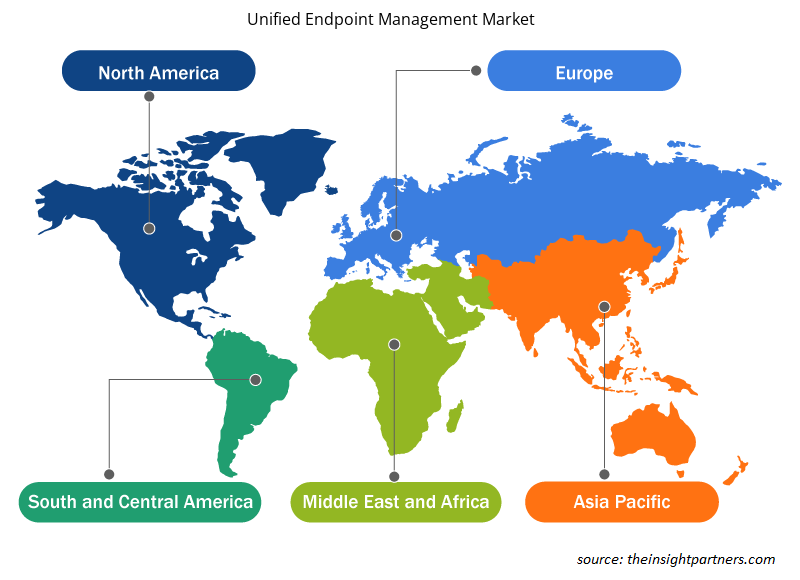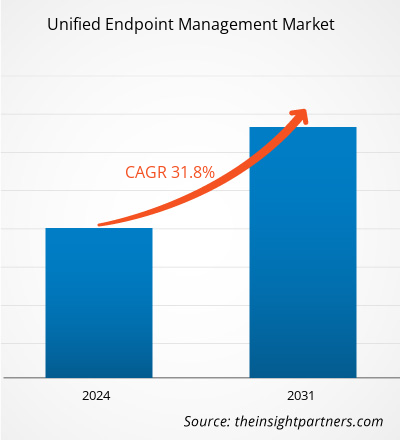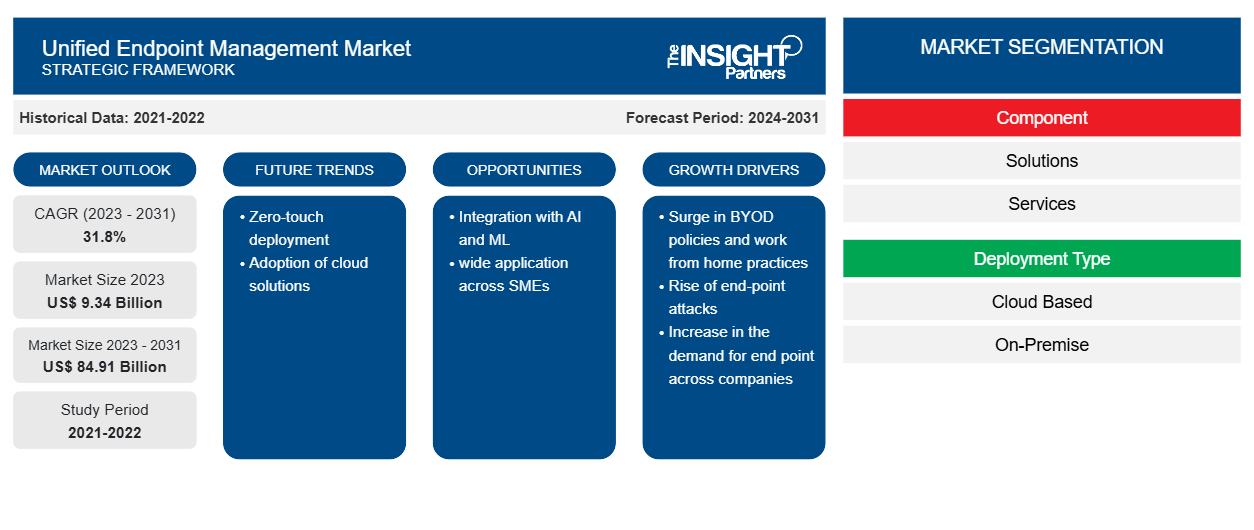Der Markt für einheitliches Endpunktmanagement soll von 9,34 Milliarden US-Dollar im Jahr 2023 auf 84,91 Milliarden US-Dollar im Jahr 2031 anwachsen. Der Markt wird zwischen 2023 und 2031 voraussichtlich eine durchschnittliche jährliche Wachstumsrate von 31,8 % verzeichnen. Die Zero-Touch-Bereitstellung und die Einführung cloudbasierter Lösungen in Unternehmen werden wahrscheinlich neue Trends auf den Markt bringen.
Marktanalyse für einheitliches Endgerätemanagement
Die steigende Nachfrage nach hoher Sicherheit und effizienter Verwaltung von Endpunkten und der zunehmende Trend zu mobilen Mitarbeitern treiben die Einführung einheitlicher Endpunktverwaltungslösungen in Unternehmen unterschiedlicher Größe voran. Mit dem wachsenden Trend zur Digitalisierung, zu intelligenten Arbeitsplätzen und zur Automatisierung wird die Nachfrage nach einheitlichen Endpunktverwaltungslösungen in den kommenden Jahren voraussichtlich stark steigen.
Fortschritte in der Informationstechnologie und bei digitalen Anwendungen haben die IT-Ressourcen weltweit erhöht. Laut dem Bericht von Cisco werden bis Ende 2021 über 27,1 Milliarden Geräte mit dem Internet verbunden sein. Unternehmen setzen zunehmend auf höherwertige Modelle, um die Hardwareanforderungen für aktualisierte Betriebssysteme wie Windows 10 und ChromeOS zu erfüllen. Mit der zunehmenden Nutzung von Endgeräten wie Laptops, Tablets, Mobiltelefonen und Desktops in Unternehmen steigt die Notwendigkeit, diese Endgeräte von einer einzigen Plattform aus zu verwalten, was zu einer steigenden Nachfrage nach einheitlichen Lösungen führt. Der wachsende Trend zur Implementierung von Richtlinien, die privaten Geräten den Zugriff auf Unternehmensdaten ermöglichen, ist ein weiterer Faktor, der den Markt antreibt.
Marktübersicht für einheitliches Endpunktmanagement
Mit den von verschiedenen Unternehmen angebotenen Tools für Unified Endpoint Management (UEM) können Kunden alle Server, Geräte und Endpunkte in einer Organisation über eine einheitliche Konsole verwalten und sichern. Es handelt sich auch um eine Kombination aus mehreren Lösungen wie Enterprise Mobility Management , Mobile Content Management, Mobile Application Management, Mobile Device Management und Client Management. Unified Endpoint Management-Lösungen decken verschiedene Plattformen ab – wie Windows, macOS, iOS, Android und Wear OS – und verschiedene Geräte, darunter Desktops, Laptops, Smartphones, Tablets und Wearables. Diese Lösungen unterstützen alle Mobilitätsanwendungsfälle in Organisationen, von unternehmenseigenen, speziell angefertigten oder gemeinsam genutzten Geräten bis hin zu BYOD-Geräten. Zu den wichtigsten Vorteilen von Unified Endpoint Management-Lösungen gehören Endpunktverwaltung, Benutzerprofilverwaltung, Dashboards, Berichterstellung, Mobilgeräteverwaltung sowie Patching und Endpunktsicherheit. Aufgrund all dieser Funktionen und Vorteile erfreuen sich diese Lösungen und die zugehörigen Dienste in den Bereichen IT und Telekommunikation, Gesundheitswesen, BFSI, Regierung, Einzelhandel und anderen Endbenutzerbranchen zunehmender Beliebtheit.
Passen Sie diesen Bericht Ihren Anforderungen an
Sie erhalten kostenlose Anpassungen an jedem Bericht, einschließlich Teilen dieses Berichts oder einer Analyse auf Länderebene, eines Excel-Datenpakets sowie tolle Angebote und Rabatte für Start-ups und Universitäten.
- Holen Sie sich die wichtigsten Markttrends aus diesem Bericht.Dieses KOSTENLOSE Beispiel umfasst eine Datenanalyse von Markttrends bis hin zu Schätzungen und Prognosen.
Markttreiber und Chancen für Unified Endpoint Management
Anstieg von BYOD-Richtlinien und Homeoffice-Praktiken
Der Ausbruch der COVID-19-Pandemie führte zu einer verstärkten Nutzung des Homeoffice-Modells, was zu einem Anstieg der BYOD-Richtlinien in verschiedenen Organisationen führte. BYOD ermöglicht es Mitarbeitern, persönliche Geräte wie Tablets, Computer und Smartphones zu verwenden , um auf vertrauliche Unternehmensdaten, Ressourcen und Anwendungen zuzugreifen. Laut dem Bericht von Cybersecurity Insiders 2021 verwenden insgesamt 82 % der Organisationen BYOD. Eine von 271 Cybersicherheitsexperten durchgeführte Umfrage ergab, dass 70 % der Organisationen ihre Mitarbeiter ihre eigenen Geräte an den Arbeitsplatz mitbringen lassen. BYOD gilt auch für Auftragnehmer (26 % der Organisationen), Partner (21 %), Kunden (18 %) und Lieferanten (14 %). Laut Jamf verwendeten im Juli 2023 außerdem etwa 75 % der Menschen persönliche Geräte für die Büroarbeit, was zu einer Produktivitätssteigerung von 34 % führte; außerdem können Organisationen mit einer BYOD-Plus-Stipendienrichtlinie etwa 250 US-Dollar pro Mitarbeiter sparen. Die einheitliche Endpunktverwaltung hilft bei der Verwaltung der BYOD-Richtlinien von Unternehmen und bietet robuste Sicherheitsmaßnahmen wie Verschlüsselung und sichere Zugriffskontrollen, die für den Schutz von Unternehmensdaten auf persönlichen Geräten von entscheidender Bedeutung sind. Darüber hinaus umfassen die Arbeitsplätze eine Kombination aus Büroangestellten, Hybrid- und Remote-Mitarbeitern, die zunehmend ihre persönlichen Geräte verwenden, um von überall aus zu arbeiten. Laut „The National Institute of Standards and Technology“ erlaubten beispielsweise im Dezember 2022 mehr als 95 % der Unternehmen ihren Mitarbeitern, ihre eigenen Geräte für die Arbeit von zu Hause aus zu verwenden. Laut Finance Online veranlasste die COVID-19-Pandemie 85 % der Unternehmen außerdem dazu, BYOD-Richtlinien einzuführen. Die zunehmende Implementierung von BYOD setzt Unternehmen unter Druck, die gesamte Remote-Arbeit der Mitarbeiter zu überwachen, da die Vielfalt der Geräte, die auf Unternehmensnetzwerke zugreifen, zugenommen hat. Lösungen zur einheitlichen Endpunktverwaltung bieten eine zentrale Verwaltung für alle Endpunkte. Der Anstieg der BYOD-Richtlinien und der Arbeit von zu Hause aus steigert daher die Nachfrage nach Lösungen zur einheitlichen Endpunktverwaltung, was das Marktwachstum ankurbelt.
Integration mit künstlicher Intelligenz und maschinellem Lernen
Fortschrittliche Technologien verändern die Arbeitsweise des IT-Sektors rasant. Unified Endpoint Management-Lösungen nutzen die Leistungsfähigkeit von KI- und Machine-Learning-Integrationen, um die allgemeine Sicherheitsstrategie durch kontextbezogene Analysen und tiefere Einblicke zu erweitern. Mit modernsten Methoden können Sicherheitsteams Vorschläge zu Warnungen, Branchenrichtlinien, bösartigen Bedrohungen usw. erhalten, die die Produktivität steigern und ihre Umgebung sichern. Auf maschinellem Lernen basierende Sicherheit bietet eine Zero-Trust-Architektur, die eine effiziente Multi-Faktor-Autorisierung und andere Authentifizierungs-, Verschlüsselungs-, Analyse- und Dateisystemrechte nutzt, um den Verlust kritischer Daten zu verhindern. Darüber hinaus kann durch die Durchsetzung dynamischer Zugriffsregeln basierend auf den Geräten, der Identität und dem Kontext des Benutzers sichergestellt werden, dass nur autorisierte Anwendungen und Benutzer auf die Schutzoberfläche zugreifen können.
Die meisten Anbieter von Unified Endpoint Management integrieren KI und ML in ihre Produktlinien, um ihren Wert zu steigern und ihre Angebote zu differenzieren. KI-basiertes integriertes Endpoint Management bietet einen umfassenden Ansatz für das Gerätemanagement, der die Sicherheit verbessern kann. Durch die Nutzung von KI-Algorithmen zur Automatisierung vieler Aufgaben im Zusammenhang mit dem Endgerätemanagement können Unternehmen das Risiko von Sicherheitsverletzungen verringern. Darüber hinaus kann KI-basiertes Unified Endpoint Management Unternehmen dabei helfen, Probleme zu priorisieren und Maßnahmen zu ergreifen, bevor sie zu schwerwiegenden Problemen werden, indem es Echtzeiteinblicke in den Gerätezustand und die Nutzungsmuster bietet. Darüber hinaus integrieren verschiedene Unternehmen, darunter Blackberry, KI und ML in Unified Endpoint Management. Daher wird die Integration von künstlicher Intelligenz und maschinellem Lernen in Unified Endpoint Management-Lösungen im Prognosezeitraum wahrscheinlich neue Möglichkeiten für das Marktwachstum schaffen.
Segmentierungsanalyse des Marktberichts zur einheitlichen Endpunktverwaltung
Wichtige Segmente, die zur Ableitung der Marktanalyse für einheitliches Endpunktmanagement beigetragen haben , sindKomponente, Bereitstellung, Plattform, Organisationsgröße, Endbenutzer und Geografie.
- Basierend auf den Komponenten ist der Markt in Lösungen und Dienstleistungen unterteilt. Das Segment Lösungen dominierte den Markt im Jahr 2023.
- Der Markt für einheitliches Endpunktmanagement ist je nach Bereitstellung in Cloud-basierte und On-Premise-Systeme unterteilt. Das Cloud-basierte Segment dominierte den Markt im Jahr 2023.
- In Bezug auf die Plattform ist der Markt für einheitliches Endpunktmanagement in Desktop und Mobilgeräte unterteilt. Das Desktop-Segment hatte im Jahr 2023 einen größeren Marktanteil.
- Nach Unternehmensgröße ist der Markt für einheitliches Endpunktmanagement in KMU und Großunternehmen unterteilt. Das Segment der Großunternehmen dominierte den Markt im Jahr 2023.
- In Bezug auf den Endverbraucher ist der Markt in BFSI, IT und Telekommunikation, Gesundheitswesen, Automobil, Fertigung, Einzelhandel und andere segmentiert. Das IT- und Telekommunikationssegment dominierte den Markt im Jahr 2023.
Unified Endpoint Management Marktanteilsanalyse nach Geografie
Der Markt für einheitliches Endpunktmanagement ist in fünf Hauptregionen unterteilt: Nordamerika, Europa, Asien-Pazifik (APAC), Naher Osten und Afrika (MEA) sowie Süd- und Mittelamerika. Nordamerika dominierte den Markt im Jahr 2023, gefolgt von Europa und APAC.
Der nordamerikanische Markt für Unified Endpoint Management wächst erheblich, da Unternehmen zunehmend in fortschrittliche Technologien investieren, um ihre Abläufe zu vereinfachen. Darüber hinaus treibt die Präsenz einer großen Anzahl von Unified Endpoint Management-Anbietern und ihre konsequenten Bemühungen, Sicherheitslösungen bereitzustellen und gleichzeitig hochwertige Endpoint Management-Funktionen anzubieten, das Marktwachstum in Nordamerika voran. Darüber hinaus spielen die frühe Verfügbarkeit und Einführung digitaler Sicherheitstools in der gesamten Region eine wichtige Rolle bei der Förderung der Einführung von Unified Endpoint Management-Lösungen.
Regionale Einblicke in den Markt für einheitliches Endpunktmanagement
Die regionalen Trends und Faktoren, die den Markt für Unified Endpoint Management im Prognosezeitraum beeinflussen, wurden von den Analysten von Insight Partners ausführlich erläutert. In diesem Abschnitt werden auch die Marktsegmente und die Geografie von Unified Endpoint Management in Nordamerika, Europa, im asiatisch-pazifischen Raum, im Nahen Osten und Afrika sowie in Süd- und Mittelamerika erörtert.

- Holen Sie sich die regionalspezifischen Daten für den Unified Endpoint Management-Markt
Umfang des Marktberichts zur einheitlichen Endpunktverwaltung
| Berichtsattribut | Details |
|---|---|
| Marktgröße im Jahr 2023 | 9,34 Milliarden US-Dollar |
| Marktgröße bis 2031 | 84,91 Milliarden US-Dollar |
| Globale CAGR (2023 - 2031) | 31,8 % |
| Historische Daten | 2021-2022 |
| Prognosezeitraum | 2024–2031 |
| Abgedeckte Segmente | Nach Komponente
|
| Abgedeckte Regionen und Länder | Nordamerika
|
| Marktführer und wichtige Unternehmensprofile |
|
Dichte der Marktteilnehmer für Unified Endpoint Management: Die Auswirkungen auf die Geschäftsdynamik verstehen
Der Markt für Unified Endpoint Management wächst rasant. Dies wird durch die steigende Nachfrage der Endnutzer aufgrund von Faktoren wie sich entwickelnden Verbraucherpräferenzen, technologischen Fortschritten und einem größeren Bewusstsein für die Vorteile des Produkts vorangetrieben. Mit der steigenden Nachfrage erweitern Unternehmen ihr Angebot, entwickeln Innovationen, um die Bedürfnisse der Verbraucher zu erfüllen, und nutzen neue Trends, was das Marktwachstum weiter ankurbelt.
Die Marktteilnehmerdichte bezieht sich auf die Verteilung der Firmen oder Unternehmen, die in einem bestimmten Markt oder einer bestimmten Branche tätig sind. Sie gibt an, wie viele Wettbewerber (Marktteilnehmer) in einem bestimmten Marktraum im Verhältnis zu seiner Größe oder seinem gesamten Marktwert präsent sind.
Die wichtigsten Unternehmen auf dem Markt für Unified Endpoint Management sind:
- 42Gears Mobility Systems Pvt Ltd.
- BlackBerry Ltd
- Matrix42 AG
- MobileIron Inc
- Ivanti
- Citrix Systems Inc
Haftungsausschluss : Die oben aufgeführten Unternehmen sind nicht in einer bestimmten Reihenfolge aufgeführt.

- Überblick über die wichtigsten Akteure auf dem Markt für Unified Endpoint Management
Unified Endpoint Management-Marktnachrichten und aktuelle Entwicklungen
Der Markt für einheitliches Endpunktmanagement wird durch die Erfassung qualitativer und quantitativer Daten nach Primär- und Sekundärforschung bewertet, die wichtige Unternehmensveröffentlichungen, Verbandsdaten und Datenbanken umfasst. Nachfolgend sind einige der Entwicklungen auf dem Markt für einheitliches Endpunktmanagement aufgeführt:
- HCL Software, ein weltweit führender Anbieter von Unternehmenssoftwarelösungen, gab die Einführung seiner Lösungen BigFix Workspace und Enterprise bekannt, die das Endpunktmanagement und die Sicherheitsautomatisierung für Unternehmen weltweit revolutionieren. Mit dem Schwerpunkt auf der Verbesserung des digitalen Mitarbeitererlebnisses und der Gewährleistung einer nahtlosen Einhaltung gesetzlicher Vorschriften definieren diese innovativen Angebote die Art und Weise neu, wie Unternehmen das Endpunktmanagement in einer dynamischen Landschaft angehen.
(Quelle: HCL Software, Pressemitteilung, März 2024)
- BlackBerry Limited, der Pionier des Enterprise Mobility Managements, kündigte zwei wichtige neue Innovationen im Bereich Unified Endpoint Management (UEM) an: BlackBerry UEM at the Edge und BlackBerry UEM für das IoT.
(Quelle: BlackBerry Limited, Pressemitteilung, Oktober 2023)
Marktbericht zum Unified Endpoint Management – Abdeckung und Ergebnisse
Die „Marktgröße und Prognose für Unified Endpoint Management (2021–2031)“ bietet eine detaillierte Analyse des Marktes, die die unten genannten Bereiche abdeckt:
- Unified Endpoint Management-Marktgröße und -prognose auf globaler, regionaler und Länderebene für alle wichtigen Marktsegmente, die im Rahmen des Berichts abgedeckt sind
- Markttrends und Marktdynamiken im Bereich Unified Endpoint Management wie Treiber, Einschränkungen und wichtige Chancen
- Detaillierte PEST- und SWOT-Analyse
- Marktanalyse für einheitliches Endgerätemanagement mit wichtigen Markttrends, globalen und regionalen Rahmenbedingungen, wichtigen Akteuren, Vorschriften und aktuellen Marktentwicklungen
- Branchenlandschaft und Wettbewerbsanalyse mit Marktkonzentration, Heatmap-Analyse, prominenten Akteuren und aktuellen Entwicklungen für den Markt für einheitliches Endpunktmanagement
- Detaillierte Firmenprofile
- Historische Analyse (2 Jahre), Basisjahr, Prognose (7 Jahre) mit CAGR
- PEST- und SWOT-Analyse
- Marktgröße Wert/Volumen – Global, Regional, Land
- Branchen- und Wettbewerbslandschaft
- Excel-Datensatz
Aktuelle Berichte
Verwandte Berichte
Erfahrungsberichte
Grund zum Kauf
- Fundierte Entscheidungsfindung
- Marktdynamik verstehen
- Wettbewerbsanalyse
- Kundeneinblicke
- Marktprognosen
- Risikominimierung
- Strategische Planung
- Investitionsbegründung
- Identifizierung neuer Märkte
- Verbesserung von Marketingstrategien
- Steigerung der Betriebseffizienz
- Anpassung an regulatorische Trends





















 Kostenlose Probe anfordern für - Markt für einheitliches Endpunktmanagement
Kostenlose Probe anfordern für - Markt für einheitliches Endpunktmanagement